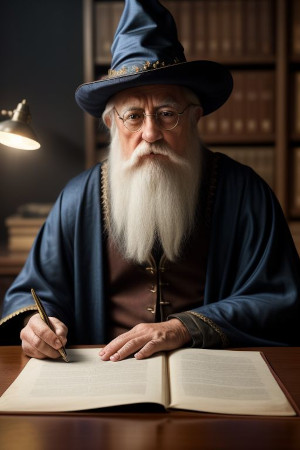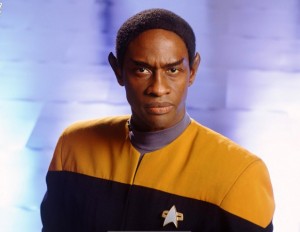2015
Aug
09
Are There Blacks in My Universe?
Star Trek: Deep Space Nine introduced a character that threw me for a loop for a moment: Commander Tuvok. A black Vulcan? Really? But as I thought about it for a few minutes, given the nature of the planet, perhaps one should be more surprised that any of them are white. It's a hot, sunny world. But the moment provoked me to an analysis: my Banak-Zuur universe is pretty much a white one, as far as humanoids are concerned.
Racism? Probably not. In first through third grades, my best friend was a black boy named Billy. I didn't learn until we moved to the all-white suburbs between third and fourth grades that dark skin was supposed to make people somehow different. Two of my grandchildren are mixed, so all in all, there is not much room in my life to be racist. But I spent much of that life in a white world: an all-white neighborhood, going to all-white schools. When I moved to the Dayton area, it was to an all-white community, where I worked at an all-white company, and went to an all-white church. Since most of The Saga of Banak-Zuur was conceived during those years, I supposed I pictured everyone as white heterosexuals because that's all I ever saw.
Of course, things changed as I got older and wiser. Angela Wickham, the protagonist of Nemesis, is a black woman, whom I picture rather like Whoopie Goldberg. One of the main characters in Sjøfn's Daughter is an asexual homoromantic. Sandra Capczek of Final Horizon is of Croatian descent. Koji Akari, not surprisingly, is Japanese. None of these were intended as an exercise in political correctness, which I despise in a free society, but rather a natural consequence of my growing up. That's just how I envisioned them with my new, widened world view. Did I say older and wiser? I don't know. In sixth grade, I wrote my first androgenous character; even I didn't know his/her physical sex. Nor, at the time, did I know that androgeny or transgenderism existed.
Because much of my attention over the past couple of years has been directed toward polishing up my Banak-Zuur universe, I couldn't help but wonder what the racial mixture of my alien humanoid races would really be. Granted, I could have made something up, but I'm the sort of person to want to look into the science and figure out the results from first principles.
Identifying the Factors
It is only logical that there would be variations in skin color, as well as other physical features, among other Population-K (humanoid, Like, TKK, whichever term you prefer) races, just as there are among humans. However, we also have to remember that the four nodal races (Trarsani, Kria-Ki, Kyattoni, and Borshcha) are some 140,000 years ahead of us, and the Valshetti were almost five million years ahead. We have to give consideration to how that additional time would affect their development.
Cessation of Natural Selection
Some evolutionary biologists have already suggested that human technology has stopped our evolution. Although others disagree, it is true that virtually everyone born into developed nations lives long enough to reproduce and therefore propagate his genes. And this does preclude natural selection as we know it. It is therefore certain that non-competitive species who had our level of technology 140,000 years ago would have eliminated their dependence on the whim of natural evolution.
On the other hand, if they hadn't, 140,000 years is plenty long enough for evolutionary change, considering that biologists believe that Europeans evolved white skin sometime in the last 8,000 years. With that in mind, we need to allow for the fact that evolution could have occurred over that time period if there was nothing in place to stop it.
Artificial Environments
As an adjunct to the end of natural selection, advanced species would have extensive artificial, possibly uniform, environments that would serve to further isolate them from any evolutionary forces dependent upon environment.
Homogenization
We are seeing this among humans, as different populations that have been traditionally isolated by geography and sheer distance are now able to intermingle and therefore interbreed. We have so many combinations that we just call mixed. We can suppose that 140,000 years from now, interbreeding would have reached a point that the entire population is essentially homogeneous and that any concept of "race" would have long since disappeared. This would be the situation that prevailed for most of the nodal races during the peak of the Triumvirate. The Trarsani are an exception because even though their technology was the most advanced in the known universe, they still almost always mate within their own communities. For them, homogenization occurred over small areas and is yet to become world-wide.
Genetic Engineering
Let's face it: these races know every connection between genotype and phenotype. They would have long since eliminated any genetic disease or hereditary weakness. Furthermore, they would be able to make modifications to themselves to fine-tune their bodies to whatever environment they choose. After all, the Trarsani went as far as to turn Lesley Kellerman into one of them. The Trarsani and Kyattoni both recognize the social problems that would arise if everyone looked the same, and so practice deliberate genetic "randomization" so that they don't.
The Consequences
So, with these background factors in mind, let's see how reality works out for each of these species.
The Trarsani
All white. Always were and always will be. As we learn in A Hierarchy of Gods, they have always lived in the deep forest or underground; over half of them have never seen their sun. Nekalee and Ritee find even the sunlight of Ithaca, New York, to be uncomfortably bright. I mentioned in this post that their darkest hair is still light blond to us. No dark pigmentation exists in their genome as no condition that would benefit from if has ever existed in their world.
The Borshcha
Who knows? The Borshcha took the evolutionary route of the aquatic ape hypothesized for humans but since discredited. They're as neotenous as the Kria-Ki, but covered with dense, smooth, brown hair. Think of them as a cross between a ninth-grader and a seal. I really don't know what color their skin is underneath, and I'm quite sure that they don't care. They have the intelligence to engineer their environment and themselves, but lack the inclination to do so.
The Kria-Ki
The Kria-Ki unquestionably reached homogenization, but they also gave up most of their technology and returned to a primitive lifestyle. That theoretically might return them to natural evolution, but their retention of medical technology would have mediated its effects. At the same time, their medical technology would allow them to optimize themselves for the area in which they live. So we can assume that, yes, there are white and black Kria-Ki according local environments. However, other original racial features that are irrelevant to location would remain homogeneous.
The Kyattoni
The Kyattoni are also homogeneous. However, with Kyatton's steep inclination, which causes it to be nicknamed "The Winter Planet", there are very few tropical areas and few that are warm year around. Consequently, there were few dark-skinned variants to begin with, only some small populations along north and south coasts near the equator, so they were swallowed up in the overwhelmingly light-skinned gene pool. Unlike the Trarsani, however, they possessed genes for dark hair, and the dominant dark genes have essentially eliminated light hair from the species, leaving even a milk-chocolate shade a rarity.
The Valshetti
The Valshetti were homogenized before the others had even evolved, and remained so. However, they had a similar proportion of dark skin as humans, and the net result was a skin color I would call bronze, or caramel, or mocha. I looked around for a celebrity who would match, and Beyoncé comes really close, though the Valshetti would have a more yellowish hue. I guess that a large percentage of Americans would call all Valshetti "black".
A Few of the Others
The Hamoni, a central feature of the Free Space Alliance in Korvoros, were created some 80,000 years ago by the Triumvirate as part of the study to understand the Population-K genetic metacode. Over half of their genetic engrams came from the Trarsani, with contributions from the Kria-Ki and Kyattoni as well as lesser Population-K species. They retain the Trarsani's light skin and hair, with mostly Kyattoni facial features and the Kria-Ki's level of neoteny.
Briashabar is a planet in many ways similar to Vulcan of the Star Trek universe, so not surprisingly, they are mostly dark skinned, looking much like the natives of desert regions in India. Shiiskituuk, too, is such a planet. As the Shiiskituuki are a bridge species they are not technically Population-K, but they also have brown skin.
The Valgro and the Tuquinthot, both more hypermorphic than humans, as well as the Dukini, who are as neotenous as the Hamoni and the Arkavikans, who closely resemble humans, have about the same range of skin color as we do.
Take another look at the picture of Commander Tuvok. Ignore his skin color and note that he has other features associated with blacks among humans: his wide nose, his prominent lips, the general shape of his skull. While I might profess that a lot of Vulcans should be black, I find it very unlikely that Vulcan skin color should correlate with other features exactly as does among humans. Possible, but not likely, unless there are some biological forces I know nothing about. So I'll make it official that although such variations should exist among other Population-K species, we should not expect them to be correlated in the same way as they are in humans. Broad noses might belong with snow-white skin somewhere in the universe.
How About Sexuality?
I live in a culture where racism is alive and well, but so is discrimination according to sexual orientation, so let's take a short look at that, too. I haven't thought about it as much, but I have some ideas bouncing around. For one, homosexual sex is physically impossible for the Kyattoni, so if homosexuality existed at one time, it would have been considered a devastating handicap and eliminated. But what about other races where the situation is less obvious?
Sexual orientation is hard to speculate on because we don't really understand the underlying psychobiology. If it is genetic, we are at a loss because exclusive homosexuals do not pass on their genes, so simplistic evolutionary theory would suggest that natural selection would have filtered it out generations ago. But it hasn't. One of the theories that makes some sense to me is the "gay uncle" theory, related to kin selection . If we accept this as the truth, which we do here only an educated guess, we can draw some conclusions.
The advanced medical technology and society of the Trarsani and Kria-Ki would have erased the effects of the kin selection mechanism and allowed conventional natural selection to take over and eliminate any "gay gene" over those 140,000 years. The Borshcha wouldn't care less, and didn't implement advanced technology, and so it is probable that the original mechanisms would remain. Overall, we can speculate that homosexuality has disappeared from the gene pool in some manner correlated with the degree of neoteny.
On a cosmic perspective, we can predict that most Population-K species would display homosexuality at about the same rate as humans. Among the most neotenous and therefore more technically advanced, except for the Borshcha, it would have been eliminated either intentionally or the through natural evolutionary processes as they would take place over a thousand centuries in a highly technological setting. There is the potential for it to have resurfaced among the Kria-Ki. The sad irony is that those races from which homosexuality would have disappeared would also be the ones with the advanced socialization that would lead them to accept it without judgment.
I haven't thought too much about the science surrounding gender identity because we know even less about that, but I do know the behavior of the nodal races. The Kyattoni don't have a sense of gender identity at all as we think of it, and among the other advanced races, it is subdued relative to us. None of the nodal races bother with significant differentiation in gender presentation or roles. They wear the same clothing, perform the same duties, and none concern themselves with ornamentation. Gendered behavior tends to increase with hypermorphism. The Valshetti, however, are an exception. As advanced as they were, they were remarkably like humans in gender identity, expression, and roles. There is nothing scientific behind this; I just assumed that gender labeling of any kind was unbecoming an advanced civilization, my political and social views coming through.
So in the end, we find that the Banak-Zuur universe is not a white one, nor a heterosexual one, nor a cis-gendered one. With the understanding that such diversity exists — not only among Population-K species but among Population-D as well — let's see how I can use that. We'll probably see a lot of diversity on Trigdru (A Remembrance of Evil).
















Comments
There are no comments for this post.
You must be logged in to post a comment.